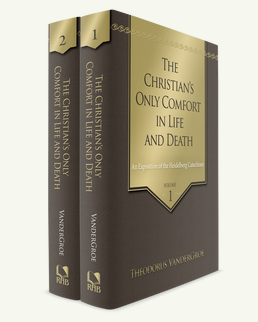This is a guest post by Rev. Bartel Elshout, the translator of The Christian’s Only Comfort in Life and Death
 RHB’s publication of The Christian’s Only Comfort in Life and Death marks another milestone in making works from the Dutch Further Reformation available to the English-speaking world. If you have benefited from reading The Christian’s Reasonable Service by Wilhelmus à Brakel, you will also relish reading the venerated exposition of the Heidelberg Catechism by Dutch divine, Theodorus VanderGroe.
RHB’s publication of The Christian’s Only Comfort in Life and Death marks another milestone in making works from the Dutch Further Reformation available to the English-speaking world. If you have benefited from reading The Christian’s Reasonable Service by Wilhelmus à Brakel, you will also relish reading the venerated exposition of the Heidelberg Catechism by Dutch divine, Theodorus VanderGroe.
VanderGroe was the last major representative of the Dutch Further Reformation—the Dutch and contemporaneous equivalent of English Puritanism. Though VanderGroe’s work does not belong to the genre of systematic theology (as is true for à Brakel’s work), his sermonic exposition of the Heidelberg Catechism addresses all the major doctrines of Scripture. This exposition has therefore always been viewed as VanderGroe’s magnum opus—a compelling reason why this new publication includes a detailed topical index.
This work has consistently been held in high esteem by the godly in the Netherlands. Not only does VanderGroe prove himself to be an able theologian in expounding the fundamental doctrines of Scripture, but this work also yields ample evidence that he was a loving, compassionate, and faithful pastor. His exposition therefore bears all the marks of Dutch and English Puritanism: it is scriptural, Christological, experiential, spiritually invigorating, and, last but not least, discriminating.
A beautiful and rich example of this is found in his exposition of Lord’s Day 7, in which he deals with the crucial subject of saving faith. He writes,
However weak or feeble faith may be, and however much it may be accompanied by strife, opposition, distrust, and carnal doubt, there will nevertheless always be, by the power and operation of the Holy Spirit, something in the heart of a Christian that constitutes the essence of true faith—all of which will not be found in an unbeliever. This continually prompts the believer, in spite of all doubt and opposition of flesh and blood, to lift up his heart by the power of the Holy Spirit and to approach God as His Father, doing so in the name of His Son, Jesus Christ, relying continually upon His grace. He does so by trusting in God’s immutable promises that He, in Christ, is to him a reconciled and gracious Father, and that for the sake of the sacrifice of Christ, He has most surely pardoned all his sins and will never be wroth with him again (Lord’s 7, 2nd sermon–Vol. 1, p. 107).
In his exposition of Lord’s Day 46, in which he deals with the address of the Lord’s Prayer, “Our Father which art in heaven,” he again encourages believers to draw near to God as their heavenly father, saying,
Believers should view God entirely as their merciful and gracious Father, and…address and refer to Him as such. And, surely, when a believer sees and has knowledge of this relationship with God, the heart is immediately moved and sweetly enamored with a childlike fear of God. The soul then is immediately filled with a tender love, respect, and reverence for God. God’s children know this by experience, for they then perceive how God, as their heavenly Father, is worthy of such childlike fear (Vol. 2, pp. 442-443).
This is but a sampling of the rich, experiential content of this work. If you are not familiar with the Heidelberg Catechism, this work will also serve as a wonderful introduction to this highly esteemed continental confession. I am therefore certain that theologians, pastors, and the believer in the pew will be amply rewarded by reading the work of a man who concludes his exposition by writing, “If it may have added, in but a small measure, to the unveiling and magnification of [God’s] infinite glory, I will deem myself to be most blessed that He has called me to be a partaker of that salvation, and that I have been given the privilege to proclaim among men the unsearchable riches of Christ, my Lord and Savior.”